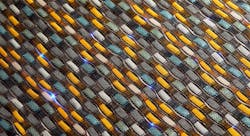Elizabeth Whelan Design Creates an Innovative Fabric Infused with LED Yarn
In today’s tech-infused world, just about any inanimate object can send a message to your phone. From wireless speakers and security systems to major appliances and furniture, these innovations have found their way into both our residential and commercial interiors. At Elizabeth Whelan Design in Portland, ME, even fabric has graduated from a decorative backdrop to an intelligent communicative device.
The textile design studio recently created its first-ever smart textile, LED 2b2, a fabric woven with a yarn embedded with LED technology that can send data. Initially installed onto a Morrison panel by Knoll for use in a commercial space, Elizabeth Whelan, founder and principal designer of Elizabeth Whelan Design, is excited about the textile’s future capabilities for real-world problems.
“It is both an aesthetically beautiful fabric and a communication device,” Whelan says. “Once the fabric is woven with the LED yarn, it can be programmed to respond in a variety of ways, and its methods of communication can be read by using an app on a mobile device.”
[Related: Top 4 Considerations When Specifying Coated Fabrics for Upholstered Seating]
The East Coast designer says she is inspired to create fabrics in which function is a major factor in design. After moving back to Maine around six years ago, after nearly 25 years of living in New York City, Whelan took a look around to see what her new environment offered in terms of design and community. A year later, she came across the Advanced Functional Fabrics of America (AFFOA), a nonprofit institute headquartered near the Massachusetts Institute of Technology (MIT), which led her on the path towards a smart textile.
Whelan defines a smart textile as: “a fabric integrated with semiconductor technology. The technology can be woven and knitted right into the fabric (in the form of a ‘smart yarn’), or applied to a pre-existing fabric by methods of printing, stitching and embroidery. These textiles can see, hear, sense, communicate, store and convert energy, regulate temperature, monitor health and change color—to name a few performance attributes. Smart textiles elevate the role of fabrics beyond the conventional forms of function and beauty and into the realm of network device systems.”
As for the initial creation of LED 2b2, Elizabeth Whelan Design was given two research and development awards by AFFOA, the first of which was to create a woven fabric using an LED yarn created by Dr. Yoel Fink at MIT. Whelan says the second award was to take this smart fabric and install it into a panel made for commercial spaces.
“Knoll was our vendor for the panel. Enrico Colzani, president of Knoll Textiles, was terrific,” she notes. “The fellows at the factory in East Greenville, [PA], imbued confidence with their skill, experience and professionalism when we worked with them during installation.”
She explains that the fabric itself utilizes three generations of light-responsive yarns:
- The white yarn, created 10 to 20 years ago, is a photoluminescent yarn, which glows in the dark.
- The silver yarn, also 10 to 20 years old, reflects light in the same way safety tape reflects a headlight’s beam.
- The LED yarn, newly created, has light emitting diodes every 10 centimeters.
“We used these three different yarns as an appreciative nod to the advancements made in the capabilities of the materials,” Whelan says. She adds that the biggest perk of incorporating the technology into fabrics is that it moves the fabric beyond its traditional uses; it can now interact with its environment and with people.
“However, we found its biggest perk can also be its biggest drawback,” Whelan adds. “The technology itself is so good and so advanced, and it’s a challenge to match that capability with a fabric. We don’t want to create a tech textile that is frivolous. The fabric needs to solve a problem and bring real solutions.”
Another perk, Whelan notes, is the technology itself can be used as a design element, creating new aesthetically pleasing patterns. However, it can be a challenge to integrate it into an overall pattern.
“What weave structures are needed to optimize its performance? What other yarn materials work well with it? When we first started working with the LED yarn, it was very fragile and broke easily,” she explains. “Now, it is very flexible, it can endure 50 washes and it functions underwater. The engineers are rapidly improving it, and that is also an inspiring perk.”
Whelan says her studio is further exploring the capabilities of the LED yarns to determine the scope of the problems they could solve. The team is embracing a technology agnostic approach by asking “What advancements are helpful to humans and our environment?” and then asking, “What role do smart fabrics play in that advancement?”
LED 2b2 is the first to provide a necessary structure for quick and effective communication. In an ever-increasing technological world, this fabric has the ability to make our homes, offices, healthcare facilities and other public spaces safer and more informed. As Whelan puts it: “The solutions are driven by the problems themselves, and the technology of smart textiles is an avenue for creativity and advancement.”
Read next: Why Fabric Matters When It Comes to Ergonomic Chairs
About the Author

Adrian Schley
Associate Editor
Adrian Schley was an Associate Editor for i+s, where she covered the commercial interior design industry since 2018. Her work can also be found in BUILDINGS and Meetings Today.
